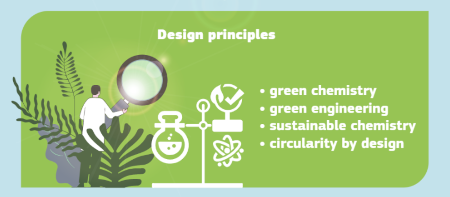The Commission Recommendation in a nutshell
The framework 'safe and sustainable by design' (SSbD) is a voluntary approach to guide the innovation process for chemicals and materials, announced in December 2022 in a Commission Recommendation.
It aims to:
- steer the innovation process in the transition towards clean and sustainable industries
- substitute or minimise the production and use of substances of concern, in line with and beyond regulatory obligations
- minimise the impact on health, climate and the environment during sourcing, production, use and end-of-life of chemicals, materials and products
The framework is composed of a (re-)design phase and an assessment phase that are applied iteratively as data becomes available.
The (re-)design phase consists of the application of guiding principles to steer the development process. The goal, the scope and the system boundaries, which will frame the assessment of the chemical or material, are defined in this phase.
The assessment phase comprises four steps: hazard, workers exposure during production, exposure during use and life-cycle assessment. The assessment can be carried out either on newly developed chemicals and materials or on existing chemicals and materials to improve their safety and sustainability performance during production, use and end-of-life.
Sign up to the SSbD stakeholder community

- Presentation
- 11 May 2023
A European assessment framework. This Commission recommendation promotes research and innovation for safer and more sustainable chemicals and materials.
Revision of the SSbD Framework
To make sure that the framework works well in practice, the Commission set up a testing period where EU Member States, businesses, universities and research organisations could try it out and provide their feedback. This testing took place over two rounds, one in 2023 and another in 2024. During this time, over 80 case studies were submitted, reviewed and discussed. In addition, two large workshops were held, each bringing together more than 500 participants.
The goal of this testing phase was to collect insights and improve the framework, making it more useful, accurate and easier to apply.
The updated version of the framework will inform the revised Commission Recommendation, expected within 2025.
Survey
Following two years of testing, the revised Safe and Sustainable by Design (SSbD) Framework is now open for consultation. Experts and everyone interested thus have the opportunity to share their views and contribute to shaping the revised Commission Recommendation 2025.
Stakeholders from industry, academia, civil society and all interested citizens are invited to complete the survey by 15 September 2025.
This feedback will help to understand better how the Framework is perceived, its clarity and its practical use, and how it can be improved to support the safe and sustainable use of chemicals and materials in Europe. It is essential to ensure that the Framework is robust, relevant and widely applicable.
The results of this consultation will inform the revision of the Commission Recommendation.
Support for the user
To help users apply the SSbD framework in practice:
- The Joint Research Centre has published a Methodological Guidance that provides practical suggestions on the most commonly encountered issues when applying the framework
- The Partnership for the Assessment of Risks from Chemicals (PARC) has developed a toolbox that provides an overview of existing tools for each step of the framework
Who should participate?
The Recommendation is addressed to EU Member States, industry, research and technology organisations (RTOs) and academia, with each stakeholder group giving feedback on different actions.
Expected actions by EU countries
- promote the framework in national research and innovation programmes
- increase the availability of findable, accessible, interoperable, reusable (FAIR) data for safe and sustainable by design assessment
- support the improvement of assessment methods, models and tools
- support the development of educational curricula on skills related to safety and sustainability of chemicals and materials
Expected actions by industry, academia and research and technology organisations (RTOs)
- use the framework when developing chemicals and materials
- make available FAIR data for safe and sustainable by design assessment
- support the improvement of assessment methods, models and tools
- support the development of professional training and educational curricula on skills related to safety and sustainability of chemicals and materials
What is in there for me?
Participants can be part of the development of a common understanding of what safe and sustainable chemicals and materials are and how to assess them.
They will benefit from regulatory preparedness by applying 'safe and sustainable by design' in their innovation process and bring SSbD to practice by promoting the framework as a common baseline and ensure that other initiatives build on it.
They can support the design and assessment of digital tools assessing safety and sustainability early in the innovation process and increase transparency of SSbD strategies to support sustainable finance and consumer awareness.
Timeline
- May - June 2023Feedback collection
- Winter 2023Workshop on collected feedback
- Spring 2024Guidance report version 1
- May - August 2024Feedback collection
- December 2024Workshop on collected feedback
- End of 2025Revision of the Commission Recommendation
- January 2026SSbD stakeholder workshop
- February 2026Guidance report version 2
